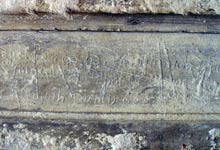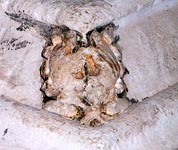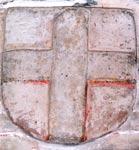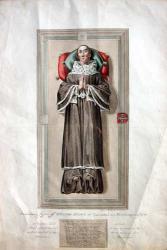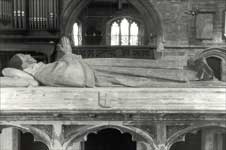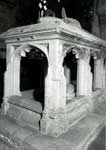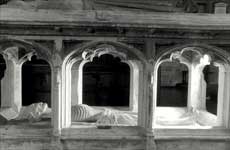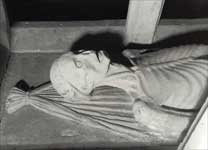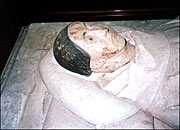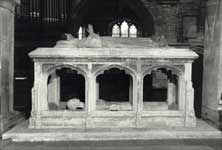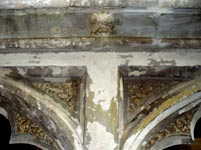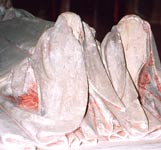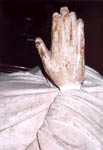Archdeacon Sponne's Tomb
Archdeacon William Sponne was Rector of Towcester from June 1422 until February 1447 when he was succeeded by Thomas Taylard. [more about Archdeacon Sponne]His monument in the church is very similar to that of Bishop Richard Fleming at Lincoln Cathedral who died 1431 in the same diocese. The monument is medieval and of a form in fashion at the time for higher ecclesiastics. It is a chest tomb, having a fully clothed effigy of the person on the top wearing a cassock, surplice and tippet, with fur-lined sleeves and collar. Beneath his effigy and inside the arches in the lower section is a representation of his emaciated corpse, indicative of mortality and evidently meant to teach humility. Cadaver tombs or table tombs were the fashion between 1420 and 1480, and surviving examples are rare, there being only about 150 still in existence. Whilst this design is rather unusual, it is the type of monument normally associated with large establishments, such as cathedrals and abbeys and to find one in a typical parish church such as St Lawrence's, clearly suggests that William Sponne was highly regarded in his own lifetime.
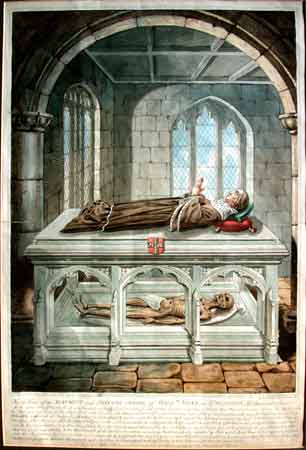 The monument is of clunch stone The sides of the tomb are open arches and on the ledge, the arms of Sponne are repeated. The head and hands are carved locally of oak with the face as a portrait; they were restored to the tomb in 1992 after being removed in 1884, lost and finally re-discovered in the attics of the Vicarage in the 1980s. At that time it was believed that the wooden appendages were themselves replacements, however radiocarbon dating in 1984 confirmed that the present wooden head is the original. The tinted prints inscribed '"Drawn on the spot" by T. Trotter' dated 1801 show clearly the wooden head attached to the tomb at that date. Over time the figure has been repainted several times and not always in the same colours. An article in the Sunday Telegraph tells of a disaster in the early 1980's when someone, not suitably qualified, repainted Archdeacon Sponne using "Humbrol" paint. Considerable restoration work was required to repair the damage.
The monument is of clunch stone The sides of the tomb are open arches and on the ledge, the arms of Sponne are repeated. The head and hands are carved locally of oak with the face as a portrait; they were restored to the tomb in 1992 after being removed in 1884, lost and finally re-discovered in the attics of the Vicarage in the 1980s. At that time it was believed that the wooden appendages were themselves replacements, however radiocarbon dating in 1984 confirmed that the present wooden head is the original. The tinted prints inscribed '"Drawn on the spot" by T. Trotter' dated 1801 show clearly the wooden head attached to the tomb at that date. Over time the figure has been repainted several times and not always in the same colours. An article in the Sunday Telegraph tells of a disaster in the early 1980's when someone, not suitably qualified, repainted Archdeacon Sponne using "Humbrol" paint. Considerable restoration work was required to repair the damage. The present position of the monument is not the original and a closely adjacent floor slab notes the following: "In a vault beneath this stone lie the remains of the Rev William Sponne Archdeacon of Norfolk whose monument was removed from this spot in November 1835 to make room for the new pewing of the Church. He died A D 1448". When this monument was removed from its original position in the chancel it was discovered that the skeleton was reportedly in a perfect state of preservation, lying on a bed of fine white sand. Within a few hours of the grave being opened the bones had crumbled to dust. The tomb has since been returned to its former position. This was supervised by Mr G Forsyth Lawson Church Architect in 1938.
The drawing of the tomb (above left) was made by T.Trotter in 1801. His inscription at bottom reads:
"North View of the MONUMENT and CHANTRY CHAPEL of WILLm. SPONN, at TOWCESTER, Northamptonshire. At the upper end of the South ile was formerly a small Chapel parted off and called Sponns Chantry, of which this Monument now forms the North side, the above gives a view of the Chapel as it now appears, the Monument itself is still in a very high state of preservation, and may be look'd upon as a truly Valuable remnant of Antiquity, for which in all probability we are indebted to the very high respect his memory is held in, by every Inhabitant of the Town of Towcester. What the emaciated Skeleton like Figure underneath is intended to represent, the Artist cannot to a certainty assertain; in his peregrinations and enquiries he has discovered no less than Six of these horrible Figures, one at Winchester; two at Salisbury, one at Frome, one at Bristol, and the present at Towcester. They are uniformly attach'd to the Monuments of Ecclesiasticks, and an interesting Tradition usually repeated by those which shew them to straingers, to substantiate their personality, but it may be with more propriety be presumed that they are given as moral Lessons; as Emblems to remind us that frail humanity tho clad in the most gorgeous Apparel, tho incensed with adulation, and pampered with delicacies, to this Complexion it must come at last."
Trotter's 1801 drawing (top of right hand column) is inscribed at the bottom:
"Recumbent figure of William Sponn at Towcester in Northamptonshire. Inscription Tablet placed against the East wall at the Foot of the Monument. Wm. Sponn sometime Archdeacon of Norfolk and Rector of Towcester gave a Messuage Close and Lands in Towcester to certain Feoffes. Their Heirs and Assignes and declared the uses thereof to be in Trust to relieve the Inhabitants from a Tax to be granted by Parliament then called a fifteenth on the Goods amounting to ten Marks as one fifteenth, if none granted then at the sound discretion of the said Feoffes to be apply'd as well in repairing the said Messuage and the Pavement of the said Town as by distribution among the Poor residing in the Parish of Towcester."
William Sponne founded a small college or chantry of two priests. One priest to say Mass for his soul after his demise, in the chapel at the east end of the south aisle of the parish church. The second priest was to teach the youth of the town. A house for the chantry was purchased next to the church. Archdeacon Sponne gave Towcester its first Grammar School. Sponne's bequests to the town are recorded on a board in the northeast angle of the chapel. He gave property to the town with the direction that the revenue was to be devoted to pave and repair the pavement of the town, the remainder to be distributed among the poor at the discretion of the feoffes.
The tomb is made of clunch, a soft chalk stone. Clunch can be cut with saws or worked with wood- working tools so was often used for decorative carving. The tomb top length is 275cm and the width 114cm. The whole tomb measures 190cm in height. There is a shield on both long sides, one of which is made of alabaster, and not the original. Marks around the top show where a brass fillet would have originally been fixed.
The tomb is described by Father J Bertram, Fellow of the Society of Antiquaries, 13th July 2006.
"Effigy of clunch, with head and hands in wood. Effigy dressed in academic costume: a long red cassock, with fringed cuffs revealing shirt underneath; tabard also red, with broad white fringe, split sleeves; cape also red, fringed, with deep pink furred hood, black pileus on head; face and hands naturalistically coloured; head resting on two cushions, the top one blue, the lower one pink, with tassels.
The Effigy lies on a flat bed made up of several small slabs, held together with iron clamps, seriously cracked along the centre line; it has a moulded edge with a chamfered recess for a brass inscription, for which rivets remain on the north, west and south sides only; at each corner is a carved spray of oak-leaves with acorns, in the centre of the north, west and south sides is a shield, of alabaster of the north, of clunch elsewhere, all originally bearing the arms of Sponne (gules, over a fess ermines, a pale ermine). On the underside mouldings are set sprays of oak-leaves, with two lions' masks on the long sides, nothing at the east end.
The slabs rest on an arcade of three arches on each side, one at each end, the spandrels and cusps on the outsides carved with oak leaves, painted gold and green, except at the east end which is blank. On the insides the spandrels are carved with oak leaves and rosettes. On the outside of each shaft is a buttress, including at the east end, painted green and red. The whole rests on a moulded plinth.
Within the tomb is a cadaver, full-length, lying on a shroud, knotted at the top; there are no remaining traces of paintings on the underside of the cover slab.
Within the indent for the brass inscription can be seen assembly marks for the elements making up the cover slab. There are also many scratches and initials, particularly on the south side, where can be read in Italic handwriting Josh Philip 1603.
The tomb was originally in the centre of the south chapel, surrounded by iron railings. Some repairs were done, presumably when it was moved, including patches to the effigy, probably the alabaster shield on the north side, and a new head and hands: the wooden originals were later re-discovered and returned.
According to Bridges (I, 276) there was a painted board with an inscription at his feet to replace the lost brass one."
Restoration of Sponne's Tomb
Conservation was undertaken between 1981 and 1993 by the conservator Miss Anna Hulbert. A radiocarbon dating undertaken by English Heritage on two cores from the head of the effigy confirmed that the hands and head were the originals of c.1448. The wooden head and hands were discovered in a box in the Vicarage.

